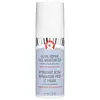What's inside
What's inside
 Key Ingredients
Key Ingredients

 Benefits
Benefits

 Concerns
Concerns

 Ingredients Side-by-side
Ingredients Side-by-side

Water
Skin ConditioningGlyceryl Stearate Se
EmulsifyingGlycerin
HumectantCaprylic/Capric Triglyceride
MaskingDimethicone
EmollientUrea
BufferingCetyl Alcohol
EmollientAvena Sativa Kernel Flour
AbrasiveSqualane
EmollientCaprylyl Glycol
EmollientButyrospermum Parkii Butter
Skin ConditioningAllantoin
Skin ConditioningPersea Gratissima Oil
Skin ConditioningN-Butyl Alcohol
PerfumingCarbomer
Emulsion StabilisingChrysanthemum Parthenium Extract
Skin ConditioningCamellia Sinensis Leaf Extract
AntimicrobialGlycyrrhiza Glabra Root Extract
BleachingSodium Hydroxide
BufferingCeramide NP
Skin ConditioningLeuconostoc/Radish Root Ferment Filtrate
AntimicrobialPhenoxyethanol
PreservativeTetrasodium EDTA
Water, Glyceryl Stearate Se, Glycerin, Caprylic/Capric Triglyceride, Dimethicone, Urea, Cetyl Alcohol, Avena Sativa Kernel Flour, Squalane, Caprylyl Glycol, Butyrospermum Parkii Butter, Allantoin, Persea Gratissima Oil, N-Butyl Alcohol, Carbomer, Chrysanthemum Parthenium Extract, Camellia Sinensis Leaf Extract, Glycyrrhiza Glabra Root Extract, Sodium Hydroxide, Ceramide NP, Leuconostoc/Radish Root Ferment Filtrate, Phenoxyethanol, Tetrasodium EDTA
Water
Skin ConditioningGlycerin
HumectantCyclohexasiloxane
EmollientIsononyl Isononanoate
EmollientCaprylic/Capric Triglyceride
MaskingButylene Glycol
HumectantCetyl Alcohol
EmollientStearyl Dimethicone
EmollientGlyceryl Stearate
EmollientStearic Acid
CleansingStearyl Alcohol
EmollientPEG-8 Stearate
EmulsifyingSynthetic Wax
AbrasiveCyclopentasiloxane
EmollientLecithin
EmollientSodium Dextran Sulfate
Gel FormingSodium Chloride
MaskingHydroxypalmitoyl Sphinganine
Skin ConditioningSodium Hyaluronate
HumectantPaeonia Suffruticosa Extract
Skin ConditioningPEG-15 Stearate
EmulsifyingEugenol
PerfumingEthylparaben
PreservativeTriethanolamine
BufferingCrithmum Maritimum Extract
Skin ConditioningPalmitic Acid
EmollientSilica
AbrasiveCellulose Acetate Butyrate
Polyphosphorylcholine Glycol Acrylate
Polycaprolactone
StabilisingPolyvinyl Alcohol
Poloxamer 188
EmulsifyingAmmonium Polyacryloyldimethyl Taurate
Emulsion StabilisingDimethiconol
EmollientLimonene
PerfumingBenzyl Alcohol
Perfuming2-Oleamido-1,3-Octadecanediol
Skin ConditioningCaprylyl Glycol
EmollientAlpha-Isomethyl Ionone
PerfumingMoringa Oleifera Seed Extract
Skin ConditioningCeramide NP
Skin ConditioningDisodium EDTA
Rosa Gallica Flower Extract
AstringentMethylparaben
PreservativeButylphenyl Methylpropional
PerfumingOctyldodecanol
EmollientParfum
MaskingPhenoxyethanol
PreservativeWater, Glycerin, Cyclohexasiloxane, Isononyl Isononanoate, Caprylic/Capric Triglyceride, Butylene Glycol, Cetyl Alcohol, Stearyl Dimethicone, Glyceryl Stearate, Stearic Acid, Stearyl Alcohol, PEG-8 Stearate, Synthetic Wax, Cyclopentasiloxane, Lecithin, Sodium Dextran Sulfate, Sodium Chloride, Hydroxypalmitoyl Sphinganine, Sodium Hyaluronate, Paeonia Suffruticosa Extract, PEG-15 Stearate, Eugenol, Ethylparaben, Triethanolamine, Crithmum Maritimum Extract, Palmitic Acid, Silica, Cellulose Acetate Butyrate, Polyphosphorylcholine Glycol Acrylate, Polycaprolactone, Polyvinyl Alcohol, Poloxamer 188, Ammonium Polyacryloyldimethyl Taurate, Dimethiconol, Limonene, Benzyl Alcohol, 2-Oleamido-1,3-Octadecanediol, Caprylyl Glycol, Alpha-Isomethyl Ionone, Moringa Oleifera Seed Extract, Ceramide NP, Disodium EDTA, Rosa Gallica Flower Extract, Methylparaben, Butylphenyl Methylpropional, Octyldodecanol, Parfum, Phenoxyethanol
 Reviews
Reviews

Ingredients Explained
These ingredients are found in both products.
Ingredients higher up in an ingredient list are typically present in a larger amount.
This ingredient is an emollient, solvent, and texture enhancer. It is considered a skin-softener by helping the skin prevent moisture loss.
It helps thicken a product's formula and makes it easier to spread by dissolving clumping compounds.
Caprylic Triglyceride is made by combining glycerin with coconut oil, forming a clear liquid.
While there is an assumption Caprylic Triglyceride can clog pores due to it being derived from coconut oil, there is no research supporting this.
Learn more about Caprylic/Capric TriglycerideCaprylyl Glycol is a humectant and emollient, meaning it attracts and preserves moisture.
It is a common ingredient in many products, especially those designed to hydrate skin. The primary benefits are retaining moisture, skin softening, and promoting a healthy skin barrier.
Though Caprylyl Glycol is an alcohol derived from fatty acids, it is not the kind that can dry out skin.
This ingredient is also used as a preservative to extend the life of products. It has slight antimicrobial properties.
Learn more about Caprylyl GlycolCeramide NP is a type of ceramide and formally known as ceramide 3.
Ceramides are intercellular lipids naturally found in our skin that bonds dead skin cells together to create a barrier. They are known for their ability to hold water and thus are a great ingredient for dry skin.
Ceramides are an important building block for our skin barrier. A stronger barrier helps the skin look more firm and hydrated. By bolstering the skin ceramides act as a barrier against irritating ingredients. This can help with inflammation as well.
If you would like to eat ceramides, sweet potatoes contain a small amount.
Read more about other common types of ceramides here:
Ceramide AP
Ceramide EOP
Cetyl Alcohol is a fatty alcohol. Fatty Alcohols are most often used as an emollient or to thicken a product.
Its main roles are:
Though it has "alcohol" in the name, it is not related to denatured alcohol or ethyl alcohol.
The FDA allows products labeled "alcohol-free" to have fatty alcohols.
Learn more about Cetyl AlcoholGlycerin is already naturally found in your skin. It helps moisturize and protect your skin.
A study from 2016 found glycerin to be more effective as a humectant than AHAs and hyaluronic acid.
As a humectant, it helps the skin stay hydrated by pulling moisture to your skin. The low molecular weight of glycerin allows it to pull moisture into the deeper layers of your skin.
Hydrated skin improves your skin barrier; Your skin barrier helps protect against irritants and bacteria.
Glycerin has also been found to have antimicrobial and antiviral properties. Due to these properties, glycerin is often used in wound and burn treatments.
In cosmetics, glycerin is usually derived from plants such as soybean or palm. However, it can also be sourced from animals, such as tallow or animal fat.
This ingredient is organic, colorless, odorless, and non-toxic.
Glycerin is the name for this ingredient in American English. British English uses Glycerol/Glycerine.
Learn more about GlycerinPhenoxyethanol is a preservative that has germicide, antimicrobial, and aromatic properties. Studies show that phenoxyethanol can prevent microbial growth. By itself, it has a scent that is similar to that of a rose.
It's often used in formulations along with Caprylyl Glycol to preserve the shelf life of products.
Water. It's the most common cosmetic ingredient of all. You'll usually see it at the top of ingredient lists, meaning that it makes up the largest part of the product.
So why is it so popular? Water most often acts as a solvent - this means that it helps dissolve other ingredients into the formulation.
You'll also recognize water as that liquid we all need to stay alive. If you see this, drink a glass of water. Stay hydrated!
Learn more about Water